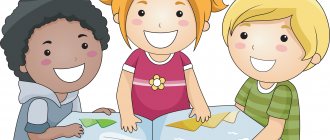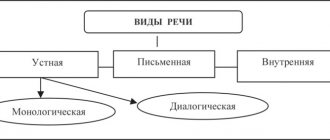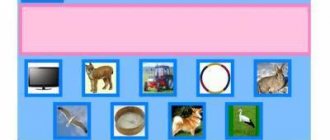Using Cinquain technology in speech development for preschoolers
The syncwine method in working with preschoolers can be used starting from the second half of the year in the senior group, when children have already mastered the concepts of “word-object”, “word-action”, “word-attribute”, “sentence”. The richer the child’s vocabulary, the easier it will be for him to construct not only a syncwine, but also to retell the text and express his thoughts.
It is appropriate to compose a didactic syncwine at the end of each lexical topic, when children already have sufficient vocabulary on this topic. At first, when compiling a syncwine, it is planned to work with children in pairs, in small groups, and only then – individually. It is necessary to encourage syncwines that contain the most accurate characteristics of various aspects of a topic or subject.
Tasks for children to compose syncwine can be different:
• to one word-subject on a lexical topic
• to different words-objects related to each other by lexical theme.
• compiling a short story based on a ready-made didactic syncwine using words and phrases that are part of this syncwine.
• correction and improvement of the finished syncwine
• analysis of an incomplete syncwine to determine the missing part (for example, a syncwine is given without indicating the topic - without the first line, it is necessary to determine it based on the existing ones).
The higher the level of speech development of the child, the more interesting the syncwines are. The apparent simplicity of the form of this technique hides a powerful, multifaceted tool for reflection. After all, assessing information, expressing thoughts, feelings and ideas in a few words, in fact, is not so easy even for an adult. This is complex and fruitful work, but poems created by children often become the “highlight” of direct educational activities.
You can give homework for joint activities between the child and parents: draw an object and compose a syncwine, which does not require much time, this game can be played even on the way to kindergarten. And as a result, when compiling it, almost all the child’s personal abilities (intellectual, creative, imaginative) are realized. Parents can make a piggy bank of syncwines with their child. Based on poems, cartoons, read stories and fairy tales, situations from life...
Sinkwine for preschoolers is:
• a means of creative self-expression for a child;
• a gaming way to enrich vocabulary;
• preparation for a brief retelling;
• mastery of concepts: word-object (living-inanimate, word-action, word-attribute;
• the ability to highlight the main idea, formulate an idea, select synonyms, correctly understand and ask questions, coordinate words in a sentence;
One of the effective and interesting methods that allows you to activate children’s cognitive activity and promote speech development is to work on producing a non-rhyming poem, a syncwine. It is believed that this technology does not require special conditions for use and its implementation, unlike composing a story, requires less time, but syncwine has more stringent conditions for the form of presentation. Cinquain is a French word that means “an unrhymed poem of five lines.” The syncwine form was created by the American poet Adelaide Crapsey. She referred to Japanese lyrical poetry of haiku and tanka. Haiku (haiku) is a Japanese tercet, while tanka is a quintet. The words in them are minimal, but each of them carries a large informational and emotional load.
Traditional (classical) syncwine as one of the genres of poetry is based on counting the syllables in each verse. Subsequently, syncwine was used for didactic purposes, that is, as an effective method for developing speech, intellectual and analytical abilities of preschool children. It has been used in many countries around the world, in Russia since the late 1990s. Preschool children can already be taught to create syncwines in a playful way. The innovation of such technology lies in the fact that conditions are created for the development of a personality who is capable of thinking critically, namely, eliminating the unnecessary and highlighting the main features, generalizing in a single word, classifying. Sinkwine is used as one of the methods for developing figurative speech, which allows you to get results quite quickly. This does not contradict the educational and correctional programs of preschool educational institutions.
The relevance and expediency of using syncwine is explained by the fact that: – new creative intellectual opportunities open up; – the dictionary is enriched and updated; – syncwine is a diagnostic tool and is carried out as part of the passage of a certain lexical topic; – there is a complex effect (speech, memory, attention, thinking develop); – this is a gaming technique; – compiling a syncwine is used for reflection, analysis and synthesis of the information received. Rules for compiling syncwine. The first line contains the topic, that is, the title of the didactic syncwine. Most often this is a phenomenon or object. It is generally accepted that this is one word, but in some cases there are small phrases. In terms of part of speech, this is a noun or pronoun; it answers the questions who? What? The second line contains two words that describe the properties and characteristics of a given object or phenomenon. Usually these are adjectives or participles that answer the questions: which one? which? which? which? The third line contains three words describing actions related to this phenomenon or object. It is believed that these are verbs that answer the questions what does? what are they doing? The fourth line contains a phrase or sentence of several words. It shows an attitude towards the topic. The most traditional option is when the sentence consists of exactly four words. However, with preschool children, strict adherence to this rule is not necessary. In this line, the sentence can consist of either three words or five. The fifth line is the last. One word is indicated - a noun. It reflects feelings and associations associated with the subject discussed in the syncwine. Instead of one there can also be two words. It is allowed to use other parts of speech.
As a rule, syncwine can be compiled in individual and subgroup lessons with children. It is allowed to give this work home for joint activities between the child and parents, for example, drawing an object and making a syncwine. Tasks for children to create a syncwine can be different: - coming up with one word-subject on a lexical topic; – compiling a short story based on a didactic syncwine using words and phrases that are part of this syncwine; – correction of a ready-made syncwine; – analysis of an incomplete syncwine to determine the missing part (for example, a syncwine was received without a corresponding topic - without the first line, and you need to determine it based on the existing ones). The higher the level of speech development of a child, the more interesting his syncwines can be. The apparent simplicity of the form hides a powerful, multifaceted tool for reflection, since evaluating information and expressing one’s thoughts, feelings, and ideas in a few words is sometimes difficult even for adults. This is complex and rewarding work. Example of syncwine: – Bear. – Brown, white. - Hunts, growls, sleeps. - Large dangerous predator. - Beast. It is very important to teach children not only to speak correctly and coherently, but also to think. The use of syncwine allows you to solve several quite important problems at once: – ensures involuntary memorization of the necessary material; – leads to the acquisition of knowledge about parts of speech and sentences; – activates vocabulary; – improves the skill of using synonyms in speech; – activates mental activity; – improves the ability to express one’s own attitude to something; – stimulates the development of children’s creative potential.
Having become familiar with the “syncwine” technology for speech development, we applied it in practice to a kindergarten with children aged 5–6 years. The lesson was called “Seasons. Spring” and was aimed at consolidating and clarifying existing knowledge about spring, enriching vocabulary and developing children’s coherent speech. The main goal was to develop students’ coherent speech by compiling syncwines using model diagrams. Verbal, practical, gaming, and visual methods were used. At the beginning of the lesson, the children were faced with the task of guessing riddles. The children enjoyed solving simple riddles on this topic. The answers consisted of words from different seasons. It was suggested to name the answers in one word, then choose some time of year and tell about it according to the diagram. After this, an audio recording of P.I. was given to listen to. Tchaikovsky "Seasons. Spring". The children were asked questions about it. The next stage of the lesson consisted of a ball game “Without which there is no spring.” Passing the ball along the chain, the children named the signs of spring, beginning their answer with the words: “Spring does not happen without...” The children showed active participation. After the game, they were asked to try to compose independent stories about spring, based on the diagram and various pictures. The expediency of using didactic syncwine is explained by the fact that this technology is quite effective, opens up new opportunities for interaction with the child and fits harmoniously into the work on speech development. It is believed that syncwine has a complex effect, since it develops not only speech, but also the higher mental functions of the child. In addition, it is an inexhaustible source for children's creativity.
Literature 1. Gogoberidze A.G. Preschool pedagogy with the basics of education and training methods: textbook. for universities / A. G. Gogoberidze, O. V. Solntseva. – St. Petersburg. : Peter, 2013. – 464 p. 2. Dushka N. Sinquain in the work on the development of speech of preschoolers / N. Dushka // Speech therapist. – 2005. – No. 5. 3. Yurchuk E. N. Experience of using modern educational technologies in the work of a teacher with preschoolers / E. N. Yurchuk // September 1. – 03/30/2017. 4. Lelyukh S. V. Development of creative thinking, imagination and speech of preschoolers / S. V. Lelyukh, T. A. Sidorchuk, N. N. Khomenko. – Ulyanovsk, 2003.








